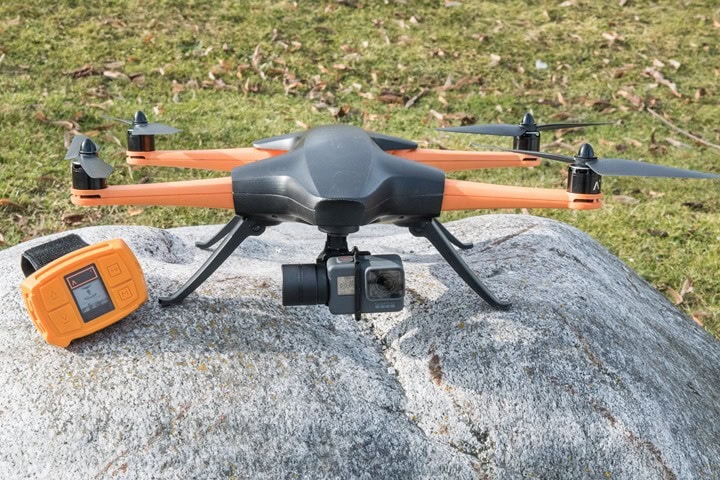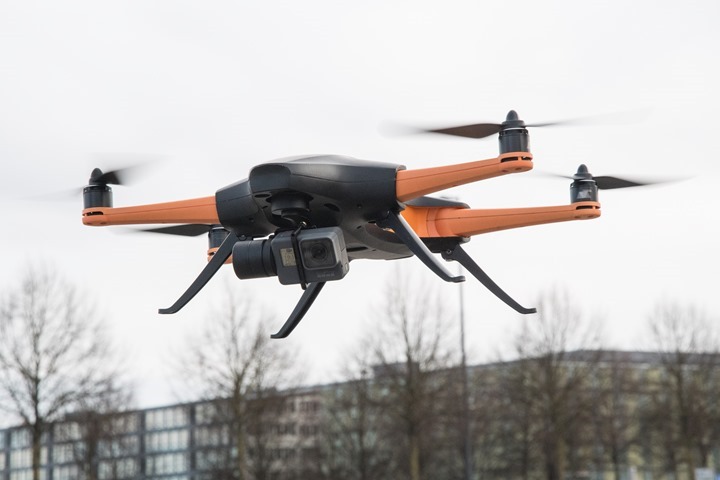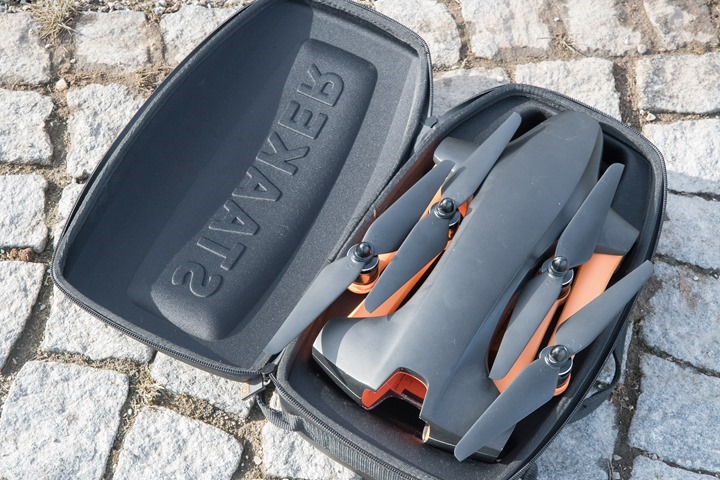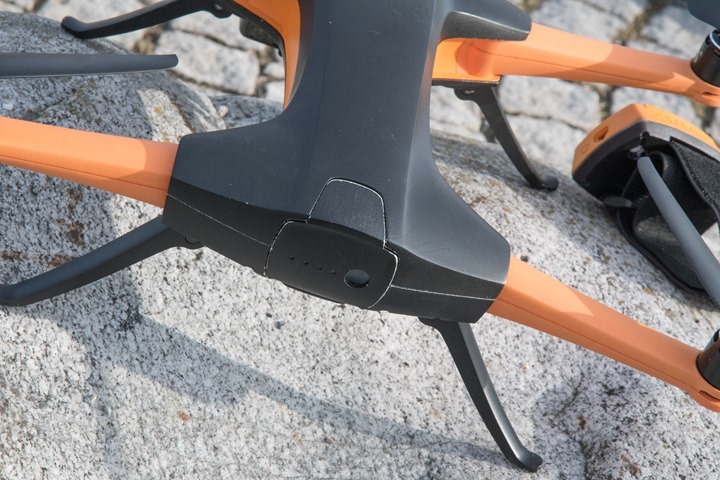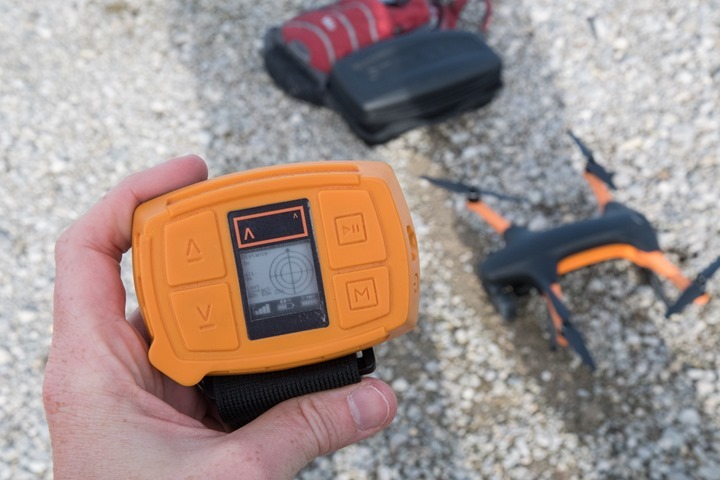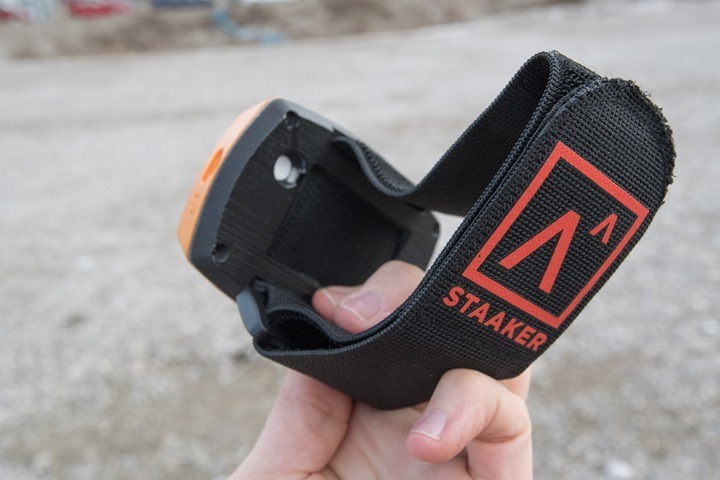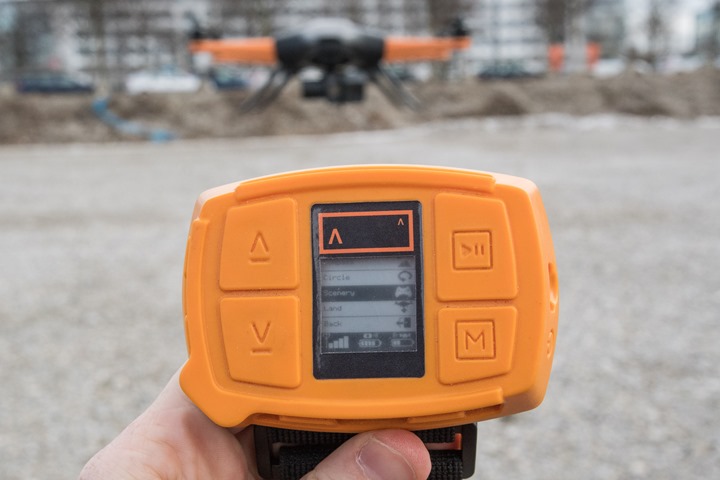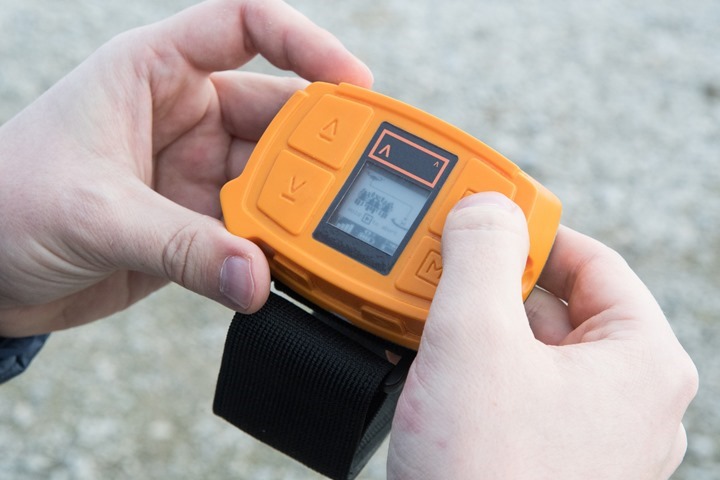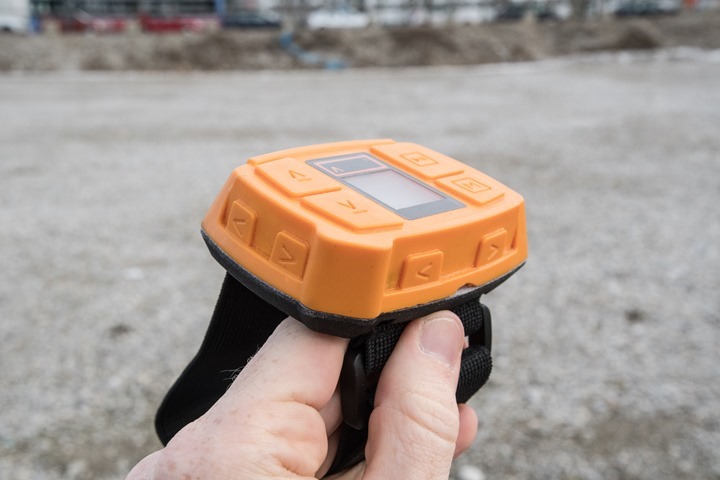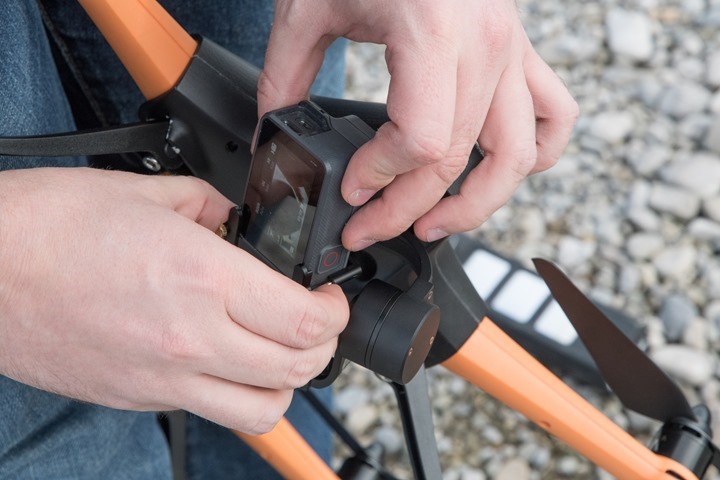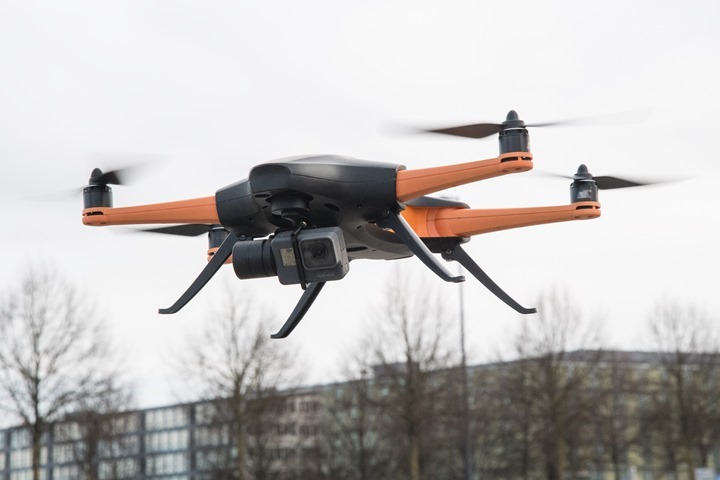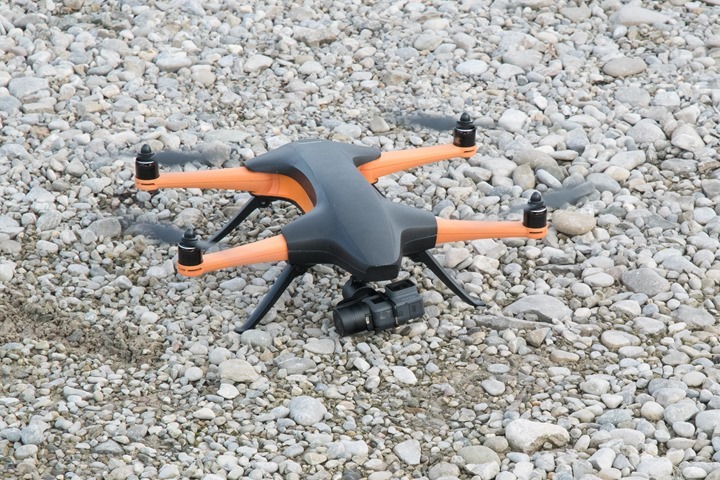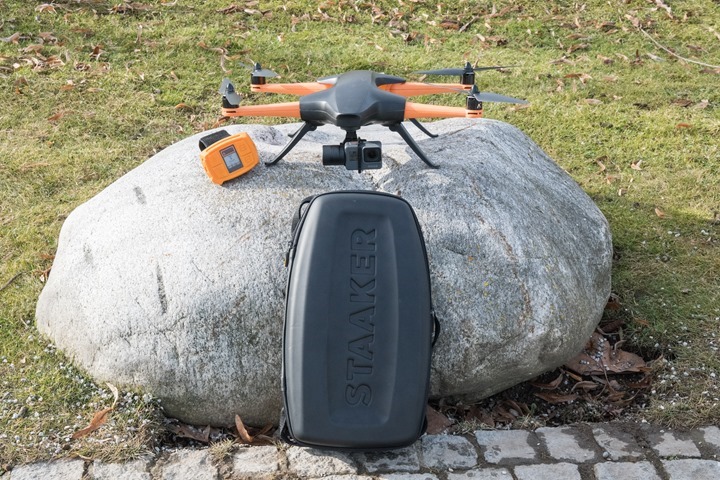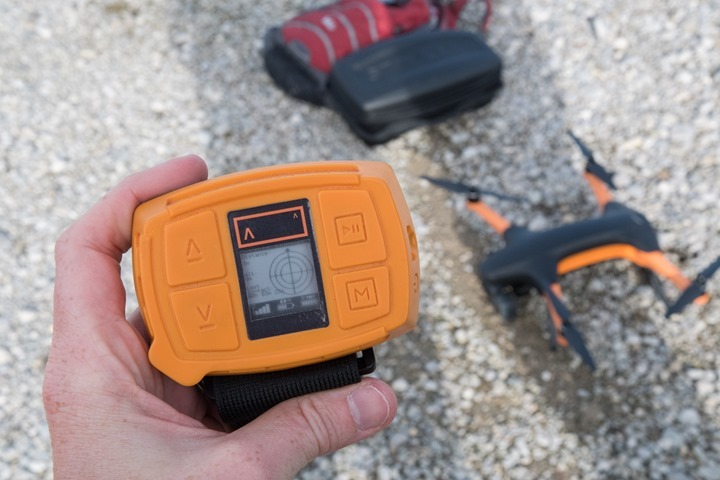While at ISPO a few days ago, I got the chance to take out the new Staaker drone for a spin. This drone is much like Airdog that I’ve reviewed previously, in that it focuses exclusively on sports action filming. More specifically: Autonomous and self-tracking filming, which is quite different than what DJI or GoPro provide. Ultimately the idea being that you wear a small waterproof transmitter pod on your arm, and it then tracks you automatically and films you accordingly. Hopefully in an epic sort of way.
However, it also has some notable differences to the Airdog which may make it a compelling option once it starts shipping. At present the company is taking pre-orders, with a plan to begin shipping later in May. But before we get too far ahead of ourselves, let’s talk tech.
Technical Overview:
The Staaker is like most new drones on the market in that it folds up to save space during transport. The unit comes in a hard-shell case that’s smaller than I expected. It’s small enough to fit inside my existing generic red backpack, if I wanted to take other things with me (my bag seen in the video a bit further down).
Once opened up, you’ll note that the props can stay on within the case – a feature not possible with Airdog. With GoPro’s Karma drone, they can stay on within the much larger/bulkier hard-shell case, but not within the softer GoPro Seeker backpack. If you’ve ever tried filming yourself and preparing a drone for flight on a @#$@’in cold day on the side of a mountain in the Alps, then saving time trying to thread props onto the drone with heavy gloves is something you’ll no doubt appreciate.
The battery also easily pops in and out from the rear of the aircraft.
Next, the unit has a dedicated transmitter/remote. This remote is fairly similar to the Airdog one, though a bit more bulky. On the flip side, it’s got slightly easier to understand functionality. When I say ‘slightly’, I mean that it still lacks text on the buttons, so you do have to remember which set of which buttons does which things. Though, given the buttons are big enough I could solve that with a felt tip marker.
The remote allows you to iterate through the various modes, which are largely autonomous in nature. Meaning each mode positions the drone in a different spot in the sky relative to you. As you ski/bike/run/whatever, the drone will automatically follow you because you are wearing the remote.
The remote and the drone both have GPS and altimeters within it, ensuring that both devices are able to track position and altitude.
The platform has the following modes:
– Circle: Rotates around you endlessly
– Compass: Stays in a given position relative to you
– Follow: Follows you from behind
– Scenery: Free-flight control
– Land: Lands the aircraft
– Hover: Stays put and camera follows you
These modes are pretty similar to what AirDog has, with the exception of the free-flight mode, which I’ll talk about in a second.
The remote is IP68 water resistant, which means it can be submerged in up to 5 meters of water (ideal for water activities like surfing). Meanwhile, the drone itself has an IP44 waterproof rating, which means rain and such is no issue. The remote has buttons which cover these core purposes:
Left Side buttons: Makes drone go closer/further
Top Left buttons: Increases elevation/decrease elevation
Bottom buttons: Makes drone go to left/right
In addition, there are dedicated buttons for take-off/landing, and changing modes. And like most drones, it’ll automatically return to home if it loses connection to the controller. And you’ve even got options you can pre-configure there too, such as returning to the point of takeoff, or returning to the last known point of you. For example, if surfing, you don’t want it to return to you – but to the beach. Whereas downhill skiing you don’t want it to return to the top of the mountain, which could be miles away.
As I noted earlier, one distinct difference to Airdog is the inclusion of a free-flight mode. In the past my general recommendation has been that if you want a cinematic-focused drone (i.e. to make videos/photos of things/scenery around you), then pickup a DJI product like the Mavic or Phantom 4. Whereas if you wanted a drone to track yourself while doing a sport, then pickup the Airdog. But the challenge was that neither drone did the others job well. For example, Airdog doesn’t really have a mode that you can fly it around as you see fit and get various shots.
These non-following shots can be useful in intro/establishing shots, as well as just general positioning that autonomous follow-me flying doesn’t cover. So this free-flight functionality is a useful feature that Staaker includes. You can use the remote in this mode allowing you to fly the drone wherever you’d like, pretty much like most other drones.
Note however that you cannot change the position of the gimbal in this free-flight mode, which stays at a 20% down angle (not bad per se), nor can you preview what you’re doing like other drones with a display on the remote. But still, for most people it’ll be better than nothing and helps fill some holes.
Speaking of the camera side – the unit has no start/stop control of your GoPro (GoPro won’t give them access), but the Staaker can accommodate most GoPro’s, including the Hero5 Black. Though, it can’t do any of the smaller square GoPro Session cameras. The company is using a 3rd party gimbal, as they noted that there was little upside in trying to re-invent the wheel where other companies have already done the work.
That gimbal means you’ll get smooth shots, and is one of the most the critical differences between a good drone and a crappy drone. The gimbal will automatically point up or down at you, based on where you are with the transmitter. In free-mode, it’ll stay at a static 20% down angle.
Still, there are some gaps here. First is that the Staaker doesn’t have any obstacle avoidance, neither forward facing or downwards. It also doesn’t have any downwards sensors. Thus when it lands, you kinda wince in that it comes down pretty hard. The company seems to understand the ramifications of that (no pun intended), in that it will automatically turn your GoPro to face the sky (upwards), protecting the lens upon landing.
But on the optical sensors, it’s a bit more of a problem. For example, my biggest issue with Airdog is that I’m constantly having to watch it in the sky to ensure it doesn’t hit trees/cliffs/objects. It lacks forward obstacle avoidance (though does have downwards avoidance). Whereas DJI for example has obstacle avoidance, though lacks good sport tracking. Still, for Staaker to have none is a huge downside.
The company argues that obstacle avoidance systems today in drones can’t handle upwards of 70KPH in speed (from a processing/avoidance standpoint). And that may well be true. But it’s also true that the vast majority of filming isn’t done at those speeds, unless you’re talking motor sports. Most of us are going between 30-40KPH in most self-propelled sports, which obstacle avoidance systems can handle just fine. Even if they were to offer the higher speeds without avoidance, that’d be an ideal compromise.
Still, the company is advertising a 30 minute long battery, which is roughly double what Airdog gets. It’s also on-par with what companies like DJI are getting in their higher end drone. The battery comes in at 1.2 pounds each (550g), and the drone itself is 3.5 lbs /1.6kg (including the battery). That’s fairly light for something tossed into your backpack.
Overview Video:
As I noted earlier, I got to spend some high quality time in a dreary parking lot with the Staaker. Which is kinda funny in a sense. Normally at conferences (this was ISPO), I’m a bit of a master at finding a random bush or tree or set of rocks to take pretty pictures of devices (even as seen above). But of course with a drone, it’s a wee bit harder to take aerial shots in a dreary place and make them super interesting.
So do keep in mind this is showing the technology, more than making a amazeballs video. Had I filmed this in the Alps or the desert, it’d look a lot cooler. But alas, a German convention center parking lot in the winter will have to do.
As I noted earlier, it’s usually easier to make things look a bit more interesting/exciting when it’s not a grey parking lot. But as Shrek says, ‘That’ll do Donkey, that’ll do’.
Going forward:
Overall, it’s definitely an interesting entrant, and certainly something to watch. At it’s current pre-order price of $1,195, it’s in the ballpark of other drones on the market, albeit notably below Airdog. Though, at their planned retail entrance price of $1,595 (same as Airdog), it’s a much harder sell (just like Airdog is at that price). Hopefully they’ll reconsider that before May 15th, 2017 – when they start shipping.
I’m loving the fact that it has a free flight mode for getting those establishing shots, and the size of the unit is much smaller than I anticipated from their site, especially given the props can stay on in the included hard shell case. Further, their inclusion of a full extra set of props is a nice touch.
One final note is that the company will be manufacturing these fully within Scandinavia, as opposed to outsourcing to Asia. That’ll likely contribute to more initial manufacturing success, as most startups have issues early on in the hardware manufacturing process due to being unable to either communicate or oversee the specific changes and quality levels they need. It should also help them hit their timelines – which is good for consumers and companies alike.
With that – thanks for reading!
























